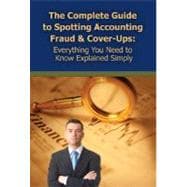
| Foreword | p. 9 |
| Introduction | p. 13 |
| Defining and Measuring Fraud | p. 19 |
| Association of Certified Fraud Examiners | p. 20 |
| Occupational Fraud | p. 21 |
| The Scope of the Problem | p. 25 |
| Who is Hurt by Fraud? | p. 26 |
| Why Fight Fraud? | p. 28 |
| Who Commits Fraud? | p. 31 |
| Scientific Study of White-Collar Crime | p. 32 |
| Gender, Age, Education, and Tenure | p. 44 |
| Collusion | p. 45 |
| Conditions Under Which Fraud Occurs | p. 45 |
| Fraud Appears to be Addictive | p. 46 |
| Fraud is Associative | p. 47 |
| Fraud Schemes Are Not Seamless | p. 48 |
| Psychopathic Behavior | p. 48 |
| How Fraud is Detected | p. 51 |
| Asset Misappropriation and Embezzlement | p. 61 |
| Skimming | p. 66 |
| Skimming red flags | p. 75 |
| Cash Larceny | p. 79 |
| Fraudulent Disbursements | p. 95 |
| Billing Schemes | p. 96 |
| Making Purchases with Company Accounts | p. 105 |
| Payroll Schemes | p. 111 |
| Check Tampering | p. 123 |
| Corruption | p. 139 |
| Conflicts of Interest | p. 142 |
| Bribery | p. 145 |
| Kickbacks and Illegal Gratuities | p. 147 |
| Detecting Bribery and Corruption | p. 149 |
| Corporate Espionage | p. 161 |
| Insider Trading | p. 169 |
| Financial Statement Fraud | p. 171 |
| Financial Statement Fraud Perpetrators | p. 172 |
| Motivation | p. 174 |
| How Financial Statement Fraud is Committed | p. 176 |
| Generally Accepted Accounting Principles (GAAP) | p. 177 |
| Types of Financial Statement Schemes | p. 181 |
| The Sarbanes-Oxley Act of 2002 | p. 197 |
| Detecting Accounting Fraud Within an Organization | p. 205 |
| Techniques for Detecting Financial Statement Fraud | p. 210 |
| Financial Statement Analysis | p. 214 |
| Ratio Analysis | p. 217 |
| Data Mining | p. 223 |
| For Investors: Detecting Financial Statement Fraud in Public Financial Statements | p. 229 |
| Where to Find Financial Statements | p. 230 |
| Foreign companies | p. 234 |
| Reading Annual Financial Statements | p. 235 |
| Red Flags for Financial Statement Fraud | p. 248 |
| Detecting Seven Types of Financial Statement Manipulations | p. 251 |
| Recording Revenue Prematurely or Exaggerating Revenue | p. 253 |
| Recording Non-Existent Revenue | p. 257 |
| Boosting Income with One-Time Gains | p. 259 |
| Shifting Current Expenses to an Earlier or Later Period | p. 261 |
| Failing to Record or Underreporting Liabilities | p. 264 |
| Shifting Current Revenues to a Later Period | p. 266 |
| Shifting Future Expenses to the Current Period as a Special Charge | p. 267 |
| Preventing Fraud in Your Company or Business | p. 269 |
| Creating an Ethical Environment | p. 270 |
| Antifraud Education | p. 273 |
| Perception of Detection | p. 273 |
| Internal Controls | p. 273 |
| Employee Hotlines | p. 276 |
| Conducting a Fraud Risk Assessment | p. 279 |
| Who Should Participate in a Fraud Risk Assessment? | p. 280 |
| Identifying Fraud Risk Factors | p. 281 |
| Evaluating Fraud Risk | p. 282 |
| Choosing and Implementing Strategies | p. 284 |
| Conducting an Internal Fraud Investigation | p. 287 |
| Deciding When and How to Conduct a Fraud Examination | p. 287 |
| Confronting the Fraud Perpetrator | p. 289 |
| Preparing for a Fraud Investigation | p. 289 |
| Putting Together a Fraud Investigation Team | p. 291 |
| Conducting the Fraud Investigation | p. 293 |
| Results of a Fraud Investigation | p. 293 |
| Finding a Professional Fraud Investigator | p. 294 |
| Conclusion | p. 297 |
| Useful Resources and Web Sites | p. 299 |
| Information on Occupational Fraud | p. 299 |
| Government and Regulatory Agencies | p. 301 |
| Internet Security | p. 305 |
| Financial Statement Research | p. 305 |
| Media | p. 307 |
| Conducting a Fraud Risk Assessment | p. 307 |
| Glossary of Terms | p. 309 |
| Bibliography | p. 319 |
| Author Biography | p. 331 |
| Index | p. 333 |
| Table of Contents provided by Ingram. All Rights Reserved. |
The New copy of this book will include any supplemental materials advertised. Please check the title of the book to determine if it should include any access cards, study guides, lab manuals, CDs, etc.
The Used, Rental and eBook copies of this book are not guaranteed to include any supplemental materials. Typically, only the book itself is included. This is true even if the title states it includes any access cards, study guides, lab manuals, CDs, etc.